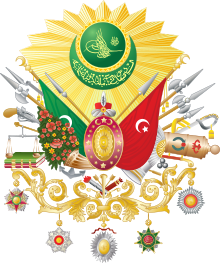
A | B | C | D | E | F | G | H | CH | I | J | K | L | M | N | O | P | Q | R | S | T | U | V | W | X | Y | Z | 0 | 1 | 2 | 3 | 4 | 5 | 6 | 7 | 8 | 9
This article needs additional citations for verification. (June 2021) |
| Modern Ottoman Army | |
|---|---|
| Turkish: Modern Osmanlı Ordusu | |
 | |
| Active | 1842/1861 – 1922 |
| Country | |
| Allegiance | |
| Type | Army |
| Size | ~3,156,000 est. (1914–1918) |
| Garrison/HQ | Constantinople |
| Engagements | World War I (Battle of Gallipoli and Siege of Kut), Arab Revolt, Tripolitanian War, Balkan Wars |
| Commanders | |
| Sultan | |
| Minister of War | Ismail Enver Pasha |
| Military of the Ottoman Empire |
|---|
 |
The Ottoman Army was the army of the Ottoman Empire after the country was reorganized along modern western European lines during the Tanzimat modernization period. It operated during the decline and dissolution of the empire, which roughly occurred between 1861 (though some sources date back to 1842) and 1918, the end of World War I for the Ottomans. The Crimean War was the first war effort in which the modern army took part in, proving itself as a decent force. The last reorganization occurred during the Second Constitutional Era.[1]
The uniforms of the modern army reflected the military uniforms of the western European countries who were the Ottoman army's principal advisors at the time. The Ottoman government considered adopting a Western-style headdress for all personnel within the army, but the fez was favoured as it was more suited to the postures of the Islamic ritual prayer.
French-style uniform and court dress were common during the early stage of the Tanzimat period. After the French defeat in the Franco-Prussian War, the Ottoman government searched for other role models, so German- and British-style uniforms became popular. During World War I, the officer uniforms were mainly based on those of the Ottoman's German allies.
Establishment of the modern army
The shift from the Classical Army (1451–1606) took more than a century and began with the failed attempts of Selim III (r. 1789–1807) and Alemdar Mustafa Pasha (1789–1808),[2] continued through a period of Ottoman military reforms (1826–1858) and finally concluded during the reign of Abdul Hamid II (r. 1876–1909). As early as 1880, Abdul Hamid sought German assistance, which he secured two years later, culminating in the appointment of Lieutenant Colonel Otto Köhler.[3][4] Although the consensus was that Abdul Hamid II favored the modernization of the Ottoman army and the professionalization of the officer corps, [when?] it seems[original research?] that he neglected the military during the last fifteen years of his reign, evidenced by his military budget cuts. The formation of the modern Ottoman army proved a slow process with various ups and downs.[citation needed]
1842–1861
-
Resembling the French line-infantry uniform
-
French-inspired palace guard dress
-
Zdroj:https://en.wikipedia.org?pojem=Ottoman_Army_(1861–1922)
Text je dostupný za podmienok Creative Commons Attribution/Share-Alike License 3.0 Unported; prípadne za ďalších podmienok. Podrobnejšie informácie nájdete na stránke Podmienky použitia.
Antropológia
Aplikované vedy
Bibliometria
Dejiny vedy
Encyklopédie
Filozofia vedy
Forenzné vedy
Humanitné vedy
Knižničná veda
Kryogenika
Kryptológia
Kulturológia
Literárna veda
Medzidisciplinárne oblasti
Metódy kvantitatívnej analýzy
Metavedy
Metodika
Text je dostupný za podmienok Creative
Commons Attribution/Share-Alike License 3.0 Unported; prípadne za ďalších
podmienok.
Podrobnejšie informácie nájdete na stránke Podmienky
použitia.
www.astronomia.sk | www.biologia.sk | www.botanika.sk | www.dejiny.sk | www.economy.sk | www.elektrotechnika.sk | www.estetika.sk | www.farmakologia.sk | www.filozofia.sk | Fyzika | www.futurologia.sk | www.genetika.sk | www.chemia.sk | www.lingvistika.sk | www.politologia.sk | www.psychologia.sk | www.sexuologia.sk | www.sociologia.sk | www.veda.sk I www.zoologia.sk



